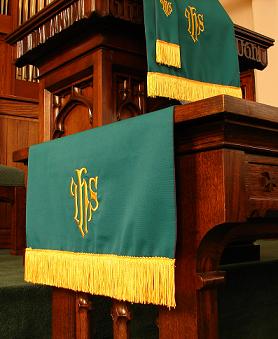THE EXTRA-ORDINARINESS
OF ORDINARY TIME
Once the two cycles of Easter and Christmas were united into a single liturgical calendar, what remained on the calendar was categorized under the heading “Ordinary Time.” The intention behind this wording is easily misunderstood. Counting can be done by cardinal numbers (i.e., one, two three, four), or it can be done by ordinal numbers (i.e., first, second, third, fourth). Ordinary Time implies no mundaneness, as if more than half the year were dull and unexiting. Rather, it refers to the fact that the Lord’s Days (Sundays) outside Advent-Christmas and Lent-Easter were simply designated by ordinal numbers (i.e., First Sunday, Second Sunday, and on through to the Thirty-fourth Sunday).
The liturgical color for the days in Ordinary Time is green. Because green is the color of new vegetation, it symbolizes living things in general and signifies the hope of new life. Green represents the promise of new life which is ours in the life of Jesus Christ our Lord. It is indeed proper and fitting for us to mark the days in Ordinary Time with the holy color of green.
Certain occasions in Ordinary Time can be interpreted as transitional Sundays into and out of the two great cycles.
- Baptism of our Lord (the Lord’s Day after Epiphany)
- Transfiguration of our Lord (the Lord’s Day prior to Ash Wednesday)
- Trinity Sunday (the Lord’s Day after the Day of Pentecost)
- Christ the King (the Lord’s Day prior to the First Sunday of Advent)
The liturgical color for these transitional Sundays is white. White represents the holiest of days in the life of the Church because it signifies the glory of our Lord, Jesus Christ. White symbolizes purity, holiness, and virtue, as well as respect and reverence. White is used for all high Holy Days and festival days of the Church year. It is indeed proper and fitting for us to mark these transitional Sundays with the holy color of white.
RETURN TO DAYS & SEASONS (When We Worship)

.jpg)
 Copyright © 2011-2014 First Presbyterian Church, Richmond, KY. All rights reserved.
Copyright © 2011-2014 First Presbyterian Church, Richmond, KY. All rights reserved.